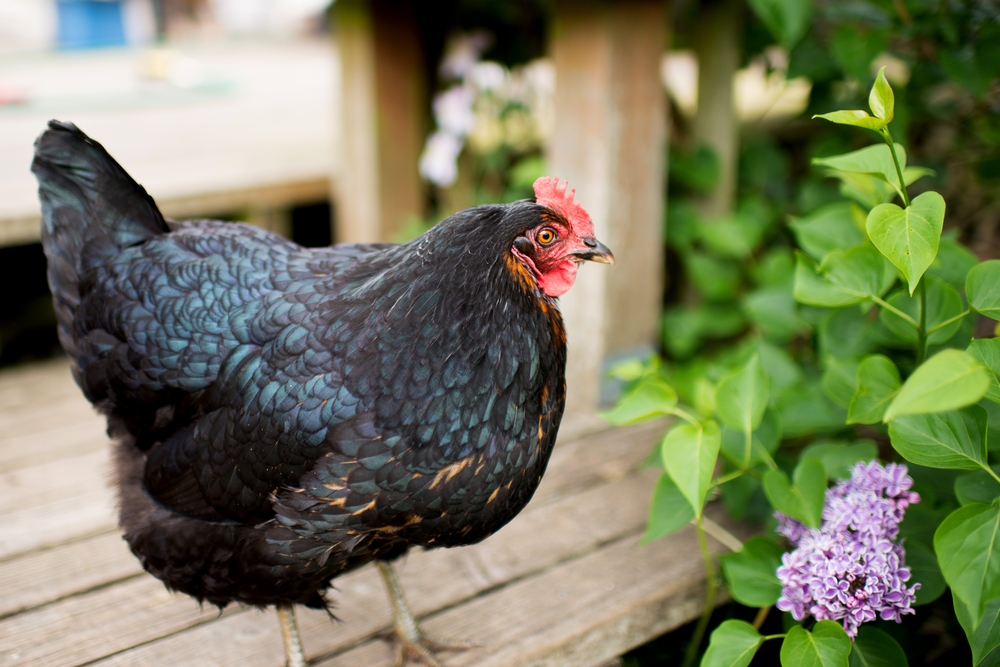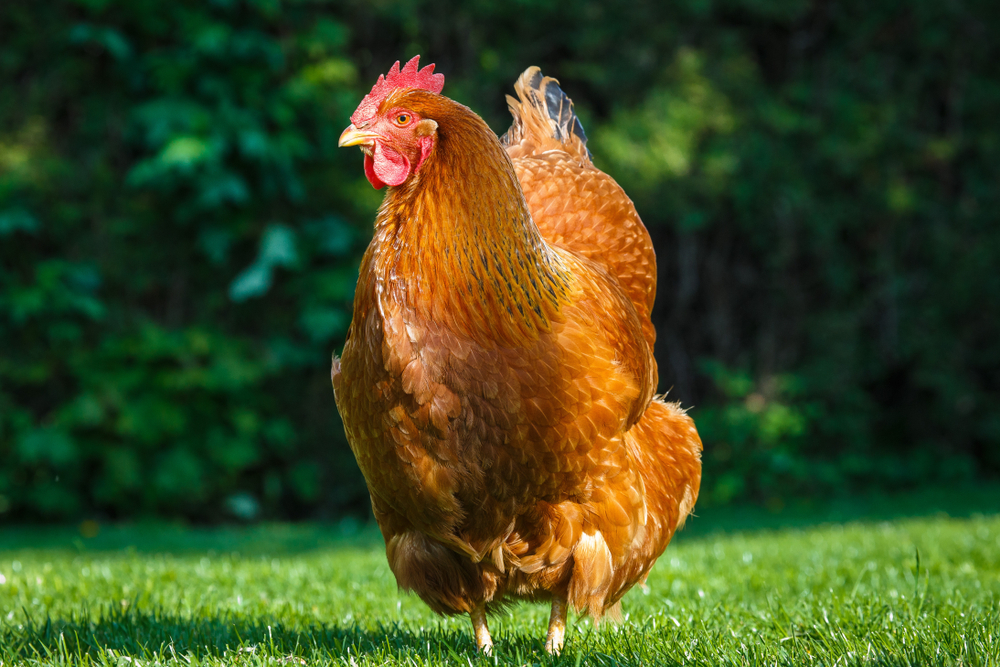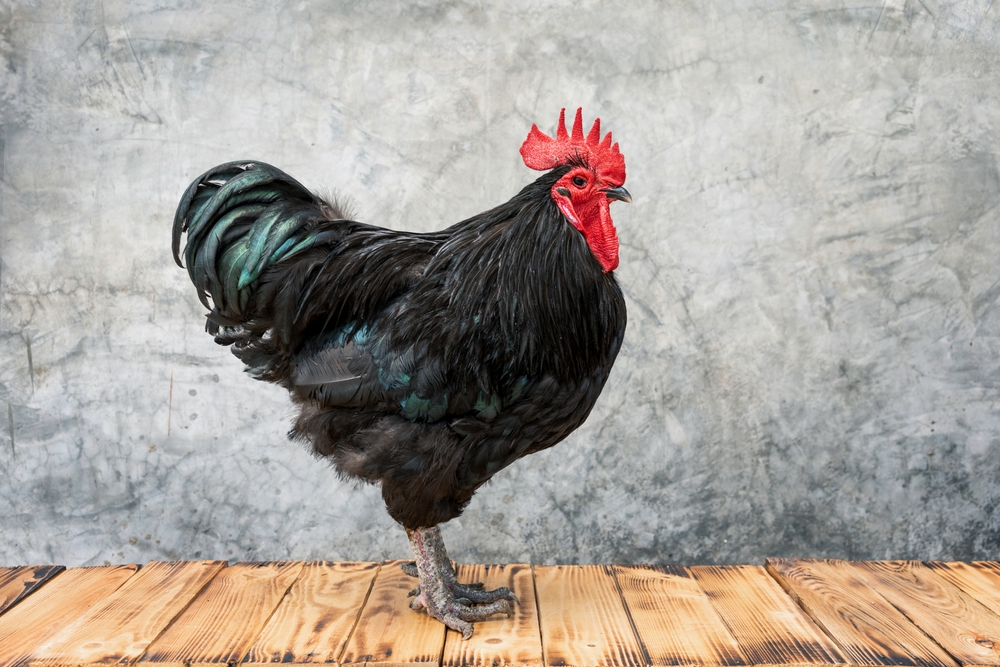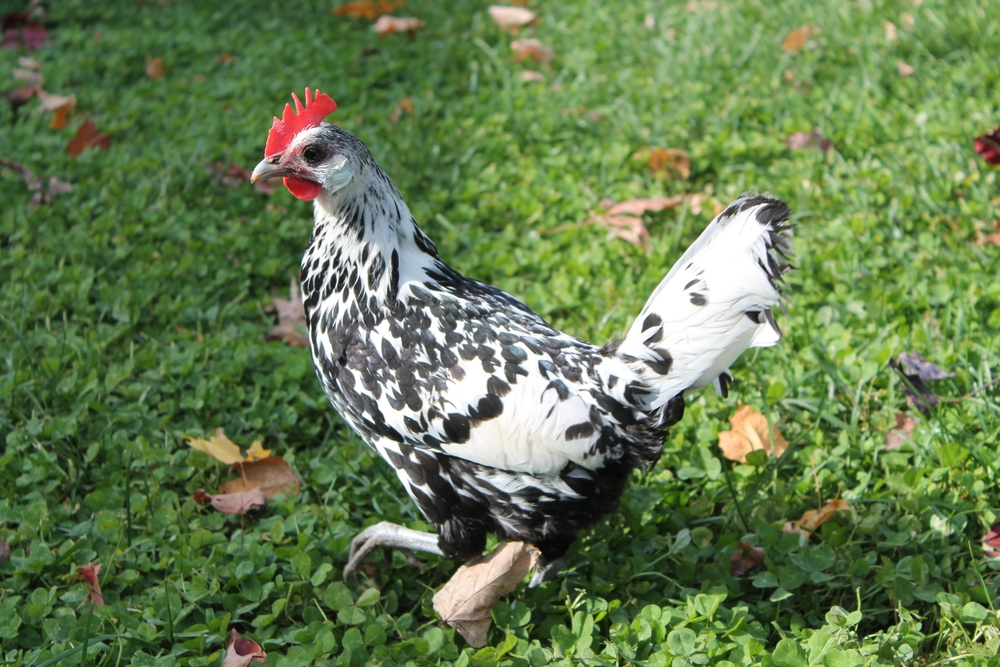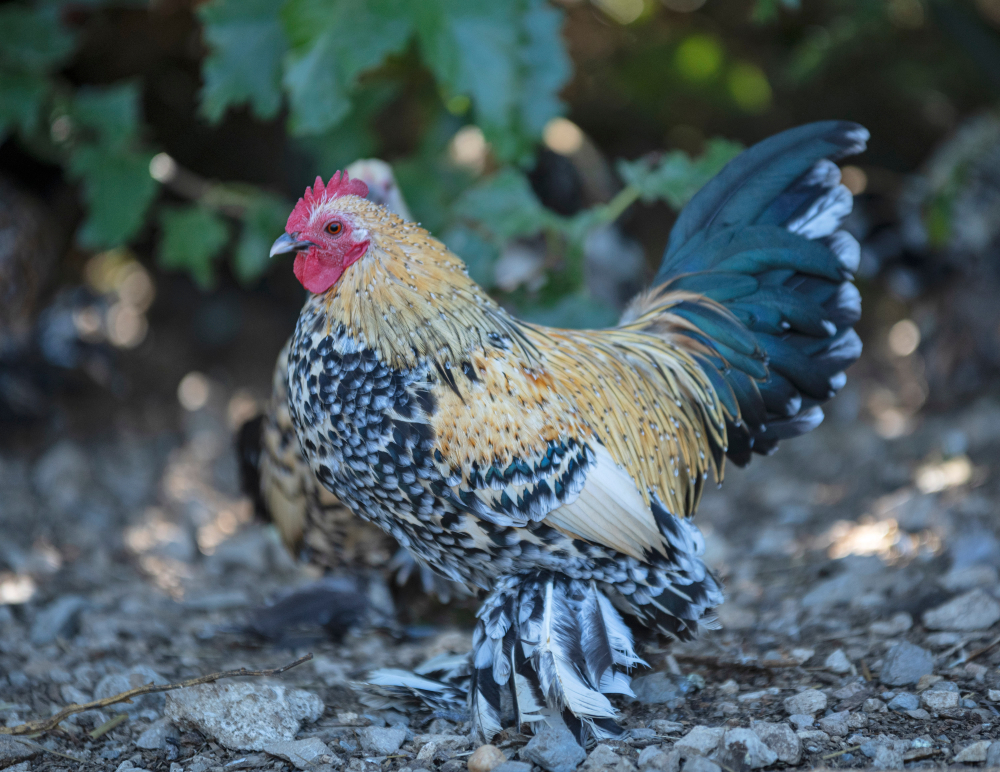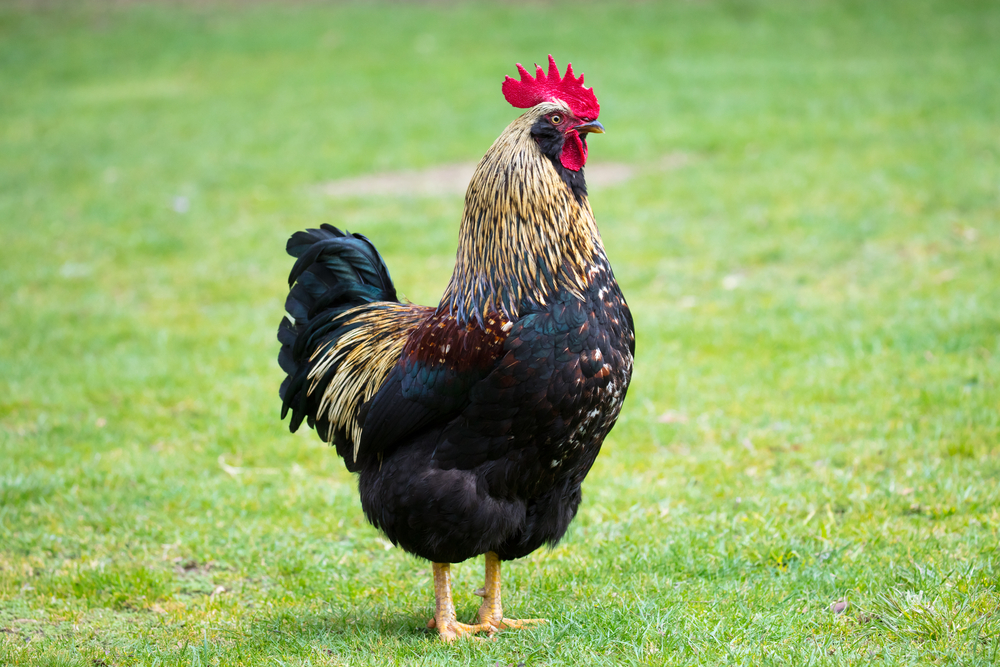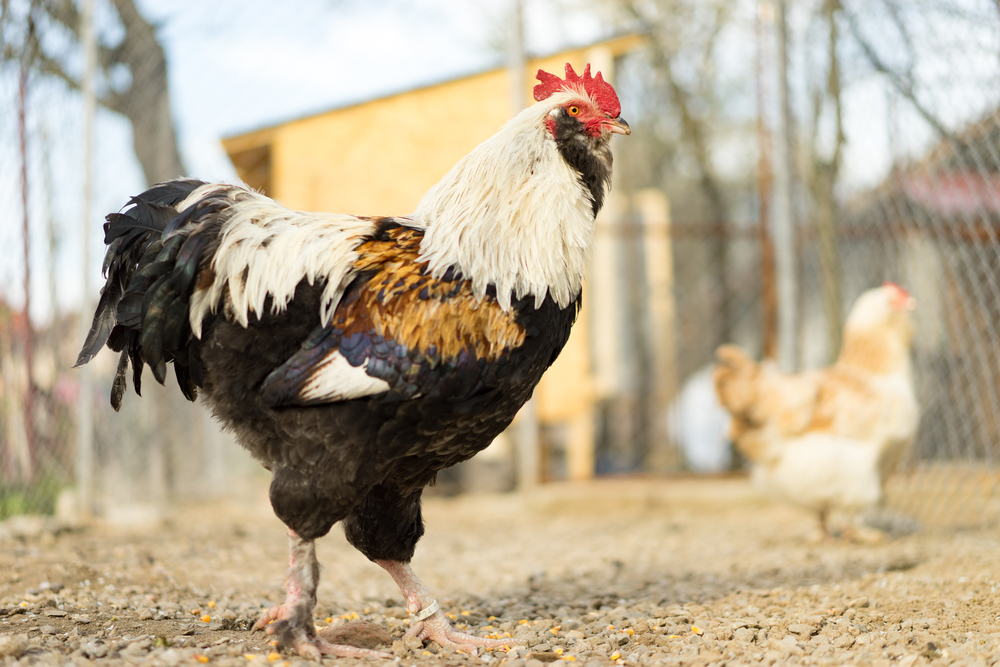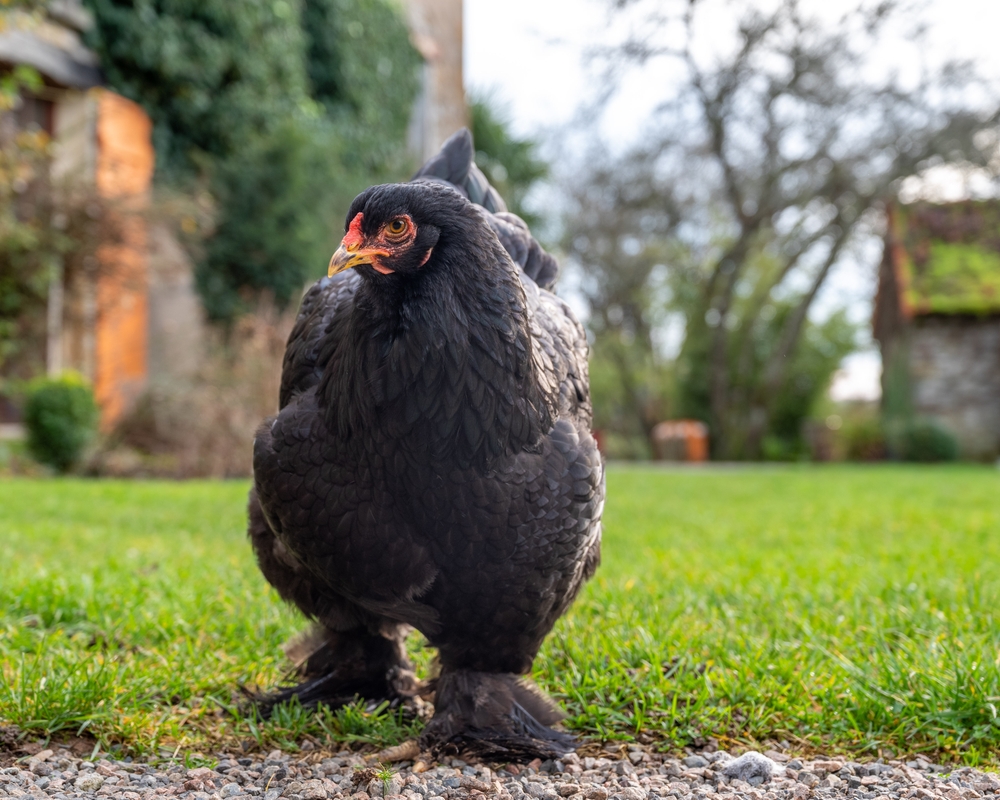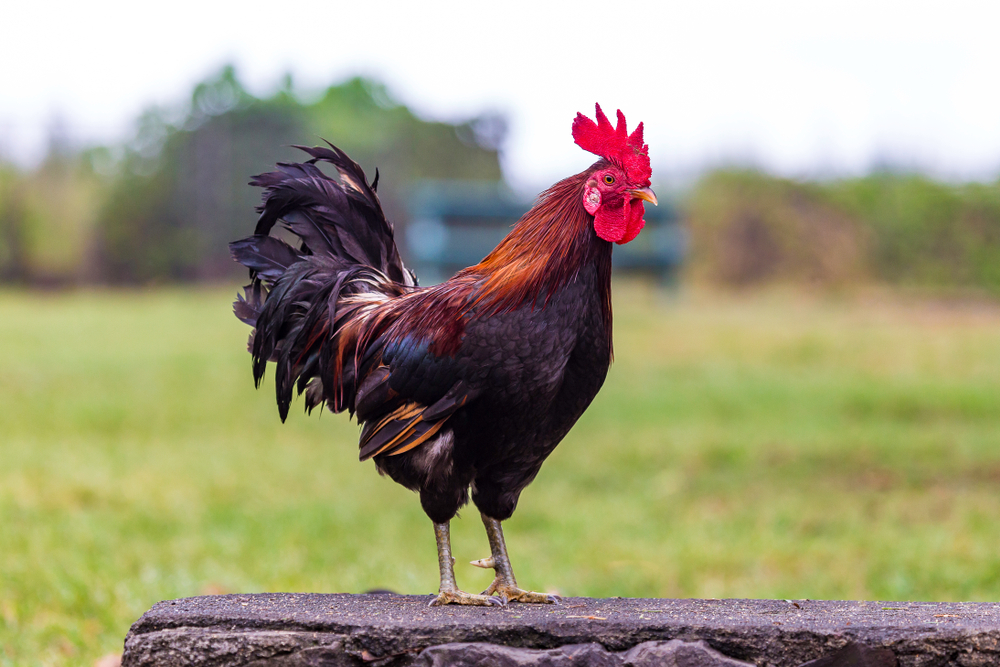The closest relative to the Jersey Giant is the Brahma, another large heritage chicken breed. Both share impressive size, cold-hardiness, and calm temperaments, but Jersey Giants grow even larger, have clean legs instead of feathered ones, and were developed specifically in the U.S. for meat production.
About
The Jersey Giant is the largest chicken breed in the world, developed in New Jersey, USA, in the late 19th century by John and Thomas Black. Originally bred as a turkey alternative for the meat market, the Jersey Giant was created by crossing Black Javas, Black Langshans, and Dark Brahmas. Its impressive size, gentle nature, and good utility have made it a valued heritage breed.
Roosters typically weigh 5.9–6.8 kg (13–15 lbs), and hens about 4.5–5.4 kg (10–12 lbs). They are massive, well-proportioned birds with broad bodies, deep chests, and strong legs. Their plumage can be black, white, or blue, with black being the most common and showing a beautiful green iridescence in sunlight. Despite their bulk, they are graceful and calm in demeanor.
Jersey Giants are dual-purpose, producing both quality meat and a steady supply of eggs. Hens lay 150–200 large brown eggs per year, often continuing through colder months. They mature more slowly than commercial broilers, but their large carcass yields tender, flavorful meat.
Known for their docile and friendly temperament, Jersey Giants integrate well into mixed flocks and are easy to handle, making them suitable for families and backyard keepers. They are good foragers when free-ranged but also adapt well to confinement.
Due to their weight, they are not strong fliers and require sturdy roosts and spacious accommodations. Their size means they eat more than average chickens, but their calm nature and utility make them a worthwhile investment for small farms.
The Jersey Giant’s scientific classification is Gallus gallus domesticus, and it belongs to the family Phasianidae.
Physical Characteristics
Plumage:
Jersey Giants have dense, close-fitting feathers that give them a sleek but substantial appearance. Recognized varieties include Black (with a greenish iridescent sheen), White, and Blue (slate-blue with darker lacing). Their plumage is smooth and lies tightly against the body, enhancing their massive frame.
Head and Comb:
The head is relatively small compared to the body, with a single, upright comb of 5 to 6 well-defined points. The comb, wattles, and earlobes are bright red, standing out against the plumage. The beak is strong and slightly curved, typically black in the Black variety, horn-colored in the White variety, and a mix in the Blue variety. Eyes are dark brown to nearly black.
Body:
Jersey Giants have a broad, deep, and long body, giving them the largest frame of any recognized chicken breed. The breast is full and well-rounded, the back is long and level, and the stance is slightly upright but well-balanced. Their build is muscular yet refined.
Legs and Feet:
The legs are long, sturdy, and clean (feather-free), with dark willow to nearly black shanks in the Black variety, slate in the Blue variety, and willow in the White variety. The feet have four strong toes each, with the undersides of the feet distinctly yellow.
Tail:
The tail is of medium length, full, and carried at a moderate angle. Roosters have long, flowing sickle feathers, while hens have shorter, more compact tails.
Size:
-
Male Weight: 13 to 15 lbs (5.9 to 6.8 kg)
-
Female Weight: 10 to 12 lbs (4.5 to 5.4 kg)
-
Bantam Variety: Much smaller but still proportionally large for a bantam, though less common.
Sexual Dimorphism:
Males are larger, with longer tail sickles, more prominent hackle and saddle feathers, and a slightly more upright carriage. Females have rounder body profiles and shorter tails.
Jersey Giants’ combination of immense size, refined balance, and variety in plumage colors makes them the heavyweight champions of the chicken world, prized for both their impressive presence and dual-purpose qualities.
Reproduction
Mating Behavior:
Jersey Giants are generally docile and calm, which makes breeding flocks easy to manage. Due to their large size, roosters may require more space during mating to avoid injuring hens. A typical breeding ratio is 1 rooster for every 8–10 hens to maintain fertility without overbreeding.
Breeding Season:
While capable of breeding year-round in moderate climates, Jersey Giants are most active reproductively in spring and early summer. In cooler regions, their cold tolerance allows them to continue breeding earlier in the year than some lighter breeds.
Egg Laying:
Jersey Giants are moderate to good layers for their size.
-
Annual Output: Around 150 to 200 large eggs per year.
-
Egg Color: Brown to light brown.
-
Egg Size: Large to extra-large.
They lay well in cooler months compared to some other heavy breeds.
Broodiness and Incubation:
-
Jersey Giant hens show low to moderate broodiness, and when they do set, they are steady and protective mothers.
-
Due to their size, care is needed to ensure they do not accidentally damage eggs during incubation.
-
Incubation Period: About 21 days, though in some cases it may extend to 22 days due to the larger egg size.
Chicks:
-
Appearance at Hatch: Fluffy, with down color varying by variety—black chicks are dark with lighter underbellies, white chicks are pale yellow, and blue chicks are slate-gray.
-
Self-Sufficiency: Active and feeding within hours of hatching.
-
Growth Rate: Slower than many breeds, taking longer to reach full size due to their large frame.
Maturity:
Jersey Giants mature more slowly than most chickens—hens usually begin laying at 6 to 8 months, and roosters reach full breeding maturity at a similar age.
The Jersey Giant’s slow growth, large egg size, and calm temperament make it a dependable dual-purpose heritage breed for those willing to wait for maturity in exchange for size and quality.
Lifespan
Lifespan in the Wild/Farm Setting:
As a domesticated heritage breed, Jersey Giants are typically kept in backyard or farm environments. With standard care, they generally live 5 to 8 years, with their most productive egg-laying years in the first 3 to 4 years before gradually declining.
Lifespan in Optimal Conditions:
With excellent nutrition, predator protection, and proactive veterinary care, Jersey Giants can live longer than the breed average.
-
Average Maximum Lifespan: 8 to 10 years
-
Exceptional cases: 10–12 years, especially in non-production flocks kept primarily for exhibition or companionship.
Threats to Longevity:
-
Predation: Due to their size and slower movement, they are vulnerable to predators such as foxes, coyotes, raccoons, hawks, and dogs.
-
Leg and Joint Strain: Their heavy body weight can lead to joint problems or bumblefoot, particularly on hard or uneven surfaces.
-
Parasites and Disease: Susceptible to lice, mites, and internal worms, as well as respiratory illnesses if kept in damp or poorly ventilated housing.
-
Heat Stress: Their large body mass and dense plumage make them prone to overheating in hot, humid climates.
Adaptations for Longevity:
Jersey Giants are cold-hardy and resilient in cooler climates, with strong immune systems and steady temperaments that help reduce stress-related health issues.
Eating Habits
Diet:
Jersey Giants are omnivorous foragers, thriving on a combination of commercial poultry feed and natural food sources.
-
Primary Feed: High-quality layer pellets or mash containing 16–18% protein, along with added calcium for strong eggshells.
-
Foraged Foods: Insects, worms, seeds, grasses, weeds, and small invertebrates found while scratching and grazing.
-
Treats and Supplements: Whole grains (corn, oats, wheat), leafy greens, vegetable scraps, grit for digestion, and oyster shell or limestone for calcium.
Feeding Behavior:
-
Jersey Giants are methodical, steady feeders rather than fast or aggressive eaters.
-
They require more feed than smaller breeds due to their size, especially during growth and egg production.
-
They drink large amounts of water to support metabolism, feather condition, and egg laying.
Foraging Times:
-
Most active in morning and late afternoon.
-
In hot weather, they forage less during midday to avoid overheating, preferring shade and rest.
Adaptations for Feeding:
-
Strong, broad beaks for breaking seeds and digging out insects.
-
Large body size allows them to forage over moderate distances, though they are less active than lighter breeds.
-
Cold-hardy nature enables them to forage comfortably in cooler weather.
Captive Diet Management:
-
Balanced feed is essential to support their slow growth rate and maintain muscle mass without excessive fat gain.
-
Overfeeding high-calorie treats can cause obesity and strain joints.
-
Ample space for movement helps maintain healthy body weight.
Jersey Giants’ steady foraging habits, high feed needs, and calm feeding behavior make them well-suited for keepers who can provide both quality feed and space for free-ranging.
Uniqueness
Largest Chicken Breed:
The Jersey Giant holds the title of the largest recognized chicken breed in the world, with roosters often weighing up to 15 lbs (6.8 kg) and hens up to 12 lbs (5.4 kg). Their massive size and impressive stature set them apart from all other domestic chickens.
American-Bred Heritage:
Developed in New Jersey, USA, in the late 1800s, they were originally bred to replace turkeys as a premium meat bird. Black Jersey Giants were the first variety, followed by White and later Blue.
Cold-Hardy Frame:
With dense plumage, a broad body, and a single comb, Jersey Giants tolerate cold weather exceptionally well and continue laying eggs in winter when many breeds slow down.
Gentle Giants:
Despite their imposing size, they are docile, calm, and easy to handle, making them suitable for mixed flocks and family-friendly environments.
Dual-Purpose Qualities:
They provide both high-quality meat and steady egg production of large brown eggs, making them a true heritage dual-purpose breed.
Slow-Growing but Long-Lived:
Jersey Giants take longer to mature than most breeds, often reaching their full size at 12 months or more, but their slower growth contributes to a solid bone structure and longevity.
Show and Exhibition Appeal:
Their commanding presence, balanced body shape, and variety of striking plumage colors make them a popular breed for poultry exhibitions.
The Jersey Giant’s massive size, calm temperament, and dual-purpose utility make it an exceptional choice for keepers seeking both beauty and practicality in a heritage breed.
Be the First to Share Photos of This Species.
FAQ’s
1. What is the closest species to the Jersey Giant?
2. How does the Jersey Giant compare to other chickens?
The Jersey Giant stands out from other breeds in several key ways:
-
Size: Largest recognized chicken breed, far heavier than common dual-purpose breeds like Rhode Island Reds or Plymouth Rocks.
-
Growth Rate: Slower to mature, often taking a year to reach full size, compared to 5–6 months for most layers.
-
Temperament: Exceptionally calm and gentle, even in roosters, making them easier to handle than many heavy breeds.
-
Utility: Balanced dual-purpose qualities with both large brown eggs and premium-quality meat.
-
Cold Tolerance: Performs well in cold climates, maintaining productivity in winter.
3. What national parks provide the best chances to see a Jersey Giant?
As a domesticated heritage breed, Jersey Giants are not found in the wild. However, they may be seen in heritage farms, agricultural fairs, and living history museums that preserve historic livestock breeds, such as:
-
Colonial Williamsburg Rare Breeds Program (Virginia, USA)
-
Old Sturbridge Village (Massachusetts, USA)
-
Billings Farm & Museum (Vermont, USA)
-
Shelburne Farms (Vermont, USA)
-
Sovereign Hill (Victoria, Australia)
These locations keep Jersey Giants as part of agricultural education and rare breed conservation programs.



































































